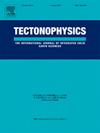Present-day stress field in SE margin of Tibetan plateau by comprehensive updated earthquake focal mechanisms and its tectonic implications
IF 2.6
3区 地球科学
Q2 GEOCHEMISTRY & GEOPHYSICS
引用次数: 0
Abstract
The Sichuan-Yunnan region of the SE and E margin of the Tibetan Plateau, situated at the transitional nexus between the seismically-active and intensely-deformed Tibetan Plateau and the tectonically stable Yangtze block with comparatively low seismicity, has experienced substantial tectonic transformations during the Quaternary. Given the pronounced seismicity, there is an escalating imperative for an accurate and refined distribution of the stress field in the region. To unravel the contemporary stress state within major active blocks and along active faults in the study area, the tectonic stress field is calculated by comprehensive updated earthquake focal mechanisms catalogue. The tectonic stress field in Sichuan-Yunnan region exhibits significant lateral variations in direction and stress pattern. The directions of the maximum and minimum principal stress in the north are nearly E-W compressions and N-S tensions, respectively. Conversely, in the south, there is a discernible clockwise rotation trend from east to west. Localized normal faulting stress regimes are observed in the middle section of Xianshuihe fault and SW side of Litang fault. The extensional environment of the former may be attributed to the tectonic activities such as block translation, clockwise rotation and the strike variation of the Xianshuihe fault from NW-SW to NNW-SSE. The latter may be related to the extensional structures, rift basins and the normal fault movements in the crust formed by the detachment of the plates and delamination of the mountain roots at the end of Triassic. We also found that the stress field under the large faults, such as Longmenshan fault, Red River fault, Xiaojiang fault and Lijiang-Xiaojinhe fault, show segmented variation. The findings yield invaluable insights into the intricate dynamics of tectonic deformation along the SE and E margin of the Tibetan Plateau.
青藏高原东南缘现今应力场的地震震源机制及其构造意义
青藏高原东南缘和东缘川滇地区,处于地震活跃、剧烈变形的青藏高原与地震活动相对较低、构造稳定的扬子地块之间的过渡节点,在第四纪经历了大量的构造改造。考虑到明显的地震活动性,对该地区准确而精细的应力场分布的要求越来越迫切。为了揭示研究区主要活动地块内和活动断裂的当代应力状态,采用更新后的地震震源机制综合目录计算了构造应力场。川滇地区构造应力场在方向和应力格局上表现出明显的横向变化。北部最大主应力方向为近东西向挤压,最小主应力方向为南北向张拉。相反,在南方,有一个明显的从东到西的顺时针旋转趋势。鲜水河断裂带中段和理塘断裂带西南侧存在局部正断层应力区。前者的伸展环境可归因于鲜水河断裂由NW-SW向NNW-SSE的板块平移、顺时针旋转和走向变化等构造活动。后者可能与三叠纪末板块分离和山根剥离形成的伸展构造、裂谷盆地和地壳正断层运动有关。龙门山断裂、红河断裂、小江断裂、丽江-小金河断裂等大断裂下应力场呈分段变化。这些发现为青藏高原东南缘和东缘构造变形的复杂动力学提供了宝贵的见解。
本文章由计算机程序翻译,如有差异,请以英文原文为准。
求助全文
约1分钟内获得全文
求助全文
来源期刊

Tectonophysics
地学-地球化学与地球物理
CiteScore
4.90
自引率
6.90%
发文量
300
审稿时长
6 months
期刊介绍:
The prime focus of Tectonophysics will be high-impact original research and reviews in the fields of kinematics, structure, composition, and dynamics of the solid arth at all scales. Tectonophysics particularly encourages submission of papers based on the integration of a multitude of geophysical, geological, geochemical, geodynamic, and geotectonic methods
 求助内容:
求助内容: 应助结果提醒方式:
应助结果提醒方式:


